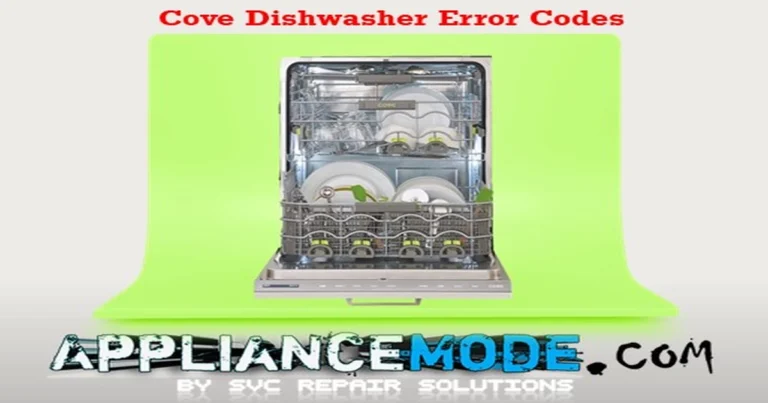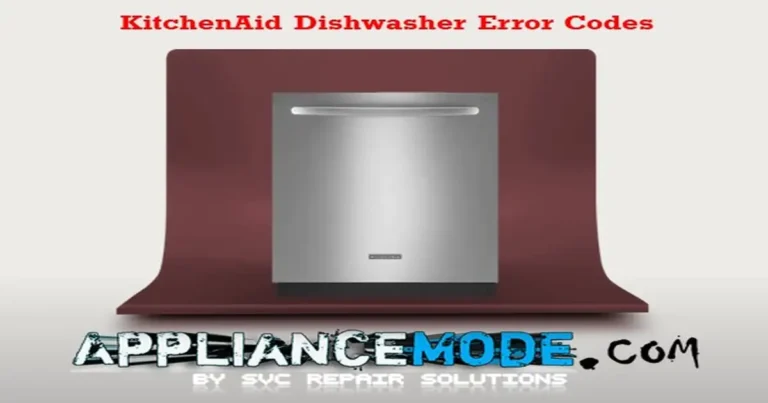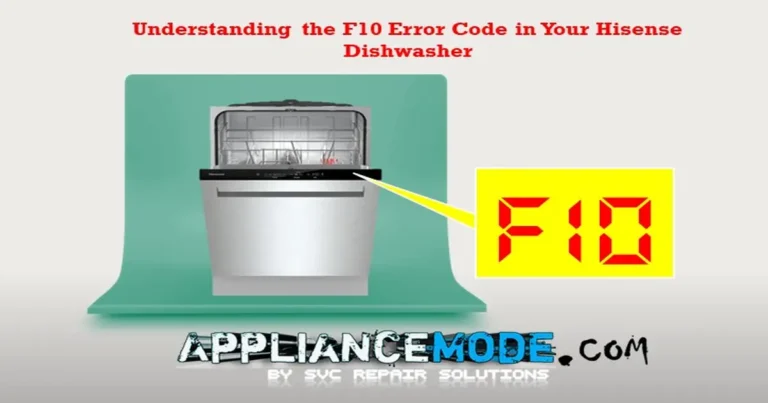Fix Your Hoover Dishwasher: A Guide to Error Codes and Troubleshooting
This comprehensive guide will walk you through common Hoover dishwasher error codes, explaining their potential meanings and providing actionable troubleshooting steps.

Important Safety Disclaimer: Before attempting any inspection or repair, ALWAYS unplug your Hoover dishwasher from the power outlet. Exercise caution when accessing internal components and if you are uncomfortable or unsure about any step, it is best to consult a qualified appliance technician.
Understanding Hoover Dishwasher Error Codes
Here is a list of common Hoover dishwasher error codes and their potential causes and solutions:
E01: Door Lock Error
This error typically indicates an issue with the dishwasher door not being closed or locked properly.
- Solutions:
- Ensure the dishwasher door is firmly closed and latched.
- Check the door latch mechanism for any obstructions or damage.
- Inspect the wiring connected to the door lock.
- In some cases, the door lock assembly may need to be replaced.
E:02 or E2: Water Inlet/Solenoid Valve Error
This code signifies that the dishwasher is not filling with water within the expected time frame.
- Potential Causes:
- Insufficient water pressure from the supply.
- Blocked or kinked inlet hose.
- Faulty water inlet valve (solenoid valve).
- Problem with the main control board.
- Solutions:
- Verify that the water tap supplying the dishwasher is fully open and that there is adequate water pressure.
- Check the inlet hose for any kinks, twists, or blockages. Clean the filter screen at the dishwasher connection point if present.
- Test the resistance of the water inlet valve with a multimeter. A typical ohmic value is around 3.90 KΩ. Replace the valve if the reading is outside the specified range.
- If the above steps don’t resolve the issue, there might be a problem with the main control board, requiring inspection and potential replacement.
E:03 or E3: Drain Pump Error
This error code indicates that the dishwasher is having trouble draining the water completely within the allocated time.
- Potential Causes:
- Blocked or kinked drain hose.
- Clogged drain pump or filter.
- Issue with the household drain line.
- Faulty drain pump.
- Problem with the pressure switch.
- Issue with the main control board.
- Solutions:
- Check the drain hose for any kinks, twists, or blockages. Ensure it is properly connected to the drain.
- Clean the dishwasher’s drain filter and sump area thoroughly. Remove any debris or foreign objects.
- Verify that your household drain is not blocked.
- Test the resistance of the drain pump with a multimeter. A typical ohmic value is around 190 Ω. Replace the pump if it’s faulty.
- Inspect the pressure switch, which monitors the water level. A malfunctioning pressure switch can sometimes cause draining issues.
- If the problem persists, the main control board may need to be checked and potentially replaced.
E:04 or E4: Water Leakage/Anti-flood Error
This code is triggered when the anti-flood switch in the base of the dishwasher detects the presence of water. This usually indicates a leak.
- Potential Causes:
- Leak from a hose, connection, or component.
- Faulty anti-flood switch.
- Problem with the drain pump (not effectively removing water).
- Issue with the main control board.
- Solutions:
- Carefully inspect all hoses, connections, and internal components for any signs of water leakage. Tighten connections or replace faulty parts/hoses as needed.
- Check if the drain pump is functioning correctly to rule out poor draining as the cause of the water accumulation.
- If there is no visible leak but the error persists, the anti-flood switch might be faulty and require replacement.
- A problem with the main control board could also falsely trigger this error.
E:05 or E5: NTC Sensor Error
This error points to a problem with the NTC (Negative Temperature Coefficient) sensor, which is responsible for measuring the water temperature.
- Potential Causes:
- Faulty NTC sensor.
- Problem with the wiring harness connector to the sensor.
- Issue with the main control board.
- Solutions:
- Inspect the wire harness connector to the NTC sensor for any loose or damaged connections.
- Test the resistance of the NTC sensor using a multimeter and compare it to the sensor temperature chart provided in your dishwasher’s service manual or reliable online resources. For example, at 20°C the resistance might be around 12580 Ω, and at 60°C around 2390 Ω. Replace the sensor if the resistance is outside the specified range.
- If the sensor and wiring appear fine, the issue could lie with the main control board.
E06: Electronic Control Fault
This general error code often suggests a problem with the main electronic control board or a communication issue. (Note: Some sources indicate E06 can also relate to unbalanced loads in washing machines, but for dishwashers, it typically points to the control board).
- Potential Causes:
- Faulty main control board.
- Communication issue between electronic components.
- Solutions:
- Try resetting the dishwasher by unplugging it for a few minutes and then plugging it back in.
- Inspect the wiring harness connected to the main control board for any visible damage or loose connections.
- If the error persists, the main control board likely needs to be inspected or replaced by a qualified technician.
E:07 or E7: Washing Motor Pump Error
This code indicates a problem with the motor pump that circulates water during the wash cycles.
- Potential Causes:
- Faulty washing motor pump.
- Problem with the motor capacitor.
- Issue with the tachometer (if applicable to your model).
- Wiring issue between the motor and the control board.
- Issue with the main control board.
- Solutions:
- Check the wiring connections between the washing motor pump and the main control board.
- If your model has a motor capacitor, test its capacitance with a multimeter. A common value is around 5 µF. Replace the capacitor if it’s outside the acceptable range.
- If your model has a tachometer, test its resistance with a multimeter (a typical value might be around 153 Ω). Replace the tachometer if it’s faulty.
- Test the resistance of the asynchronous washing motor itself (a typical value might be around 118 Ω). Replace the motor if the resistance is incorrect.
- If all other components check out, the main control board might be the issue.
E:08 or E8: Abnormal Heating Temperature Error
This error means the dishwasher is detecting an issue with reaching or maintaining the correct water temperature during the heating phase.
- Potential Causes:
- Faulty heating element.
- Problem with the heating element relay on the control board.
- Issue with the pressure switch (not detecting the correct water level for heating).
- Wiring issue related to the heating circuit.
- Faulty NTC temperature sensor (see E05).
- Issue with the main control board.
- Solutions:
- Check the wiring between the heating element and the main control board.
- Test the resistance of the heating element with a multimeter. For a 1850 watt heater at 220 Vac, the resistance should be around 26 Ω. Replace the heating element if it’s faulty.
- Check the contacts of the pressure switch with a multimeter. With water present, the resistance should be very low (0.1 – 1.0 Ω), and with no water, it should be an open circuit (OL). Replace the pressure switch if it’s not functioning correctly.
- Inspect the heater relay on the main control board. If it appears damaged or is not functioning, the main board may need replacement.
- Verify the NTC sensor is working correctly (see E05).
- If none of the above resolve the issue, the main control board could be at fault.
E:09 or E9: Turbidity Sensor Error
This error indicates a problem with the sensor that measures how cloudy or dirty the wash water is.
- Potential Causes:
- Dirty or clogged turbidity sensor.
- Excessive foam in the dishwasher tub.
- Problem with the wiring to the turbidity sensor.
- Issue with the main control board.
- Solutions:
- Clean the turbidity sensor, usually located in the sump area of the dishwasher.
- Run a few rinse cycles with the “Cold Pre-wash” function (if available) to remove any excess foam or detergent residue that might be affecting the sensor.
- Check the wiring between the turbidity sensor and the main control board for any issues.
- If the problem persists, the main control board might be faulty.
E:10 or E10: Communication Failure (Main PCB and User Control)
This error suggests a loss of communication between the main electronic control board and the user interface or control panel.
- Potential Causes:
- Loose or damaged wiring harness connecting the two boards.
- Faulty user interface/control panel.
- Faulty main control board.
- Solutions:
- Inspect the wiring harness that connects the main control board to the user interface. Ensure all connections are secure and there is no visible damage.
- If the wiring is intact, either the user interface or the main control board is likely faulty and needs to be replaced.
E:12 or E12: BLDC Washing Motor Error
This code specifically relates to an issue with a Brushless DC (BLDC) circulation pump, found in some Hoover dishwasher models.
- Potential Causes:
- Faulty BLDC motor.
- Problem with the wiring between the motor and the main control board.
- Issue with the main control board.
- Solutions:
- Check the wiring connections between the main control board and the BLDC motor.
- Measure the resistance between the windings of the BLDC motor. The resistance between U and V, V and W, and W and U should be approximately the same (a typical value might be around 62 Ω). Replace the motor if the resistances are inconsistent or outside the expected range.
- If the motor and wiring appear fine, the main control board could be the cause.
E:14 or E14: Heating Chain Error
This error points to a problem within the circuit responsible for heating the water. It can be related to several components in the heating path.
- Potential Causes:
- Issue with the wiring harness connector in the heating circuit.
- Problem with the pressure-safety microswitch.
- Faulty NTC temperature probe (see E05).
- Faulty heating element (see E08).
- Faulty heater relay on the control board (see E08).
- Solutions:
- Inspect the wiring harness connectors within the heating circuit for any loose or damaged connections.
- Check the pressure-safety microswitch for proper operation.
- Verify the resistance of the NTC probe (see E05).
- Test the resistance of the heating element (see E08).
- Check the heater relay on the main control board.
- Troubleshoot each component in the heating chain as described in their respective error code sections (E05, E08).
E:15 or E15: EEPROM Error
This indicates a problem with the EEPROM (Electrically Erasable Programmable Read-Only Memory) on the main control board, suggesting corrupted data.
- Potential Causes:
- Corrupted data on the main control board’s EEPROM.
- Faulty main control board.
- Solutions:
- This error typically requires the replacement of the main control board as the EEPROM is integrated into it.
E:16 or E16: Pressure Switch Shorted Error
This error means the pressure safety microswitch, which monitors the water level, is stuck in the “closed” position, even when there is no water.
- Potential Causes:
- Faulty pressure safety microswitch.
- Wiring issue related to the microswitch.
- Problem with the heater relay (less common).
- Solutions:
- Check the wiring harness connected to the pressure safety microswitch.
- Replace the pressure safety microswitch.
- While less likely, a faulty heater relay could potentially contribute to this error in some cases and may warrant checking.
E:17 or E17: Heater Relay Error
This refers to a problem with the relay on the main control board that controls the power supply to the heating element.
- Potential Causes:
- Faulty heater relay.
- Issue with the main control board.
- Solutions:
- In some cases, the error might be temporary. Try waiting for at least 20 minutes and see if the error clears.
- If the error persists, the heater relay on the main control board is likely faulty, requiring the replacement of the main PCB.
E:18 or E18: Water Level Error
This error indicates that the dishwasher detected an incorrect water level during the filling process. This could be too high or too low.
- Potential Causes:
- Faulty water inlet valve (solenoid valve – see E02).
- Blocked or dirty air trap chamber (part of the pressure sensing system).
- Air leakage in the pressure switch hose.
- Faulty pressure level switch.
- Solutions:
- Check the water inlet valve for proper operation (see E02).
- Clean the air trap chamber, which can become blocked with debris and affect accurate water level sensing.
- Inspect the hose connected to the pressure switch for any leaks or disconnections.
- Replace the pressure level switch if it is faulty.
E19: Heat Exchanger/Dispenser/Internal Valve Error
Based on information for similar appliances, this error can relate to the heat exchanger, dispenser, or an internal valve. Specific causes for Hoover dishwashers may vary by model.
- Potential Causes:
- Problem with the heat exchanger.
- Issue with the detergent dispenser mechanism.
- Faulty internal valve.
- Solutions:
- Due to the potential complexity and variety of causes for this error, it is often recommended to seek professional assistance for diagnosis and repair.
E20: Drain Pump Blockage/Issue
Similar to E03, this code points to a problem with the drain system, often a blockage in the drain pump. (Note: Information for E20 is commonly found for Hoover washing machines, but the principle of a drainage issue is relevant to dishwashers).
- Potential Causes:
- Blocked drain pump.
- Issue with the drain pump itself.
- Solutions:
- Access and clean the drain pump and filter area thoroughly. Remove any foreign objects.
- If the blockage is cleared and the error persists, the drain pump may be faulty and need replacement. Professional assistance might be required for pump replacement.
E:21 or E21: Solenoid Valve/Flowmeter Error
This error can indicate a problem with a solenoid valve, potentially the water inlet valve being stuck open, or an issue with the flowmeter if your model is equipped with one.
- Potential Causes:
- Water inlet valve stuck open.
- Faulty reed switch in the flowmeter.
- Problem with the flowmeter itself.
- Solutions:
- Check the water inlet valve (see E02).
- If your model has a flowmeter, you can test the reed switch within it. With the power off, locate the reed switch’s pins and use a multimeter on the continuity setting. Bring a magnet near the switch; the multimeter should indicate continuity. If it doesn’t, the reed switch is faulty.
- If the reed switch is fine, the flowmeter itself might be the issue and require replacement.
E22: Drainage System Issue
This code generally indicates a problem with the dishwasher’s drainage system. (Note: Information for E22 is commonly found for Hoover washing machines, but the troubleshooting steps for drainage are often similar).
- Potential Causes:
- Clogged filter or drain hose.
- Faulty drain pump (see E03, E20).
- Issue with the pressure switch (affecting drain signal).
- Blockage in the sump hose.
- Solutions:
- Clean the dishwasher filters and check the drain hose for blockages or kinks.
- Inspect and potentially test the drain pump.
- Check the pressure switch.
- Inspect the sump hose for blockages if you are comfortable accessing it.
- If basic checks don’t resolve the issue, professional diagnosis of the drainage system is recommended.
E23: Drain Pump Electrical Fault
This error, often seen in conjunction with drainage issues (like E20), can specifically point to an electrical problem with the drain pump circuit. (Note: Information for E23 is commonly found for Hoover washing machines).
- Potential Causes:
- Electrical fault in the drain pump or its wiring.
- Problem with the main control board affecting the drain pump circuit.
- Solutions:
- Check the electrical connections to the drain pump for any loose or damaged wires.
- The drain pump itself might have an internal electrical fault.
- The issue could stem from the main control board’s ability to power or control the drain pump. This often requires professional diagnosis and repair.
By understanding these common Hoover dishwasher error codes, you can be better equipped to diagnose problems and determine whether you can fix them yourself or if it’s time to seek professional help, ultimately getting your dishwasher back to sparkling clean dishes.

I am a master Appliance Repair technician with over 35 years of experience in the field. I am passionate about helping people troubleshoot their appliances and fix common problems. My website, appliancemode.com, provides a wealth of information on troubleshooting common appliance issues and deciphering error codes. This website aims to empower people to tackle appliance repairs themselves and save money on service calls.



